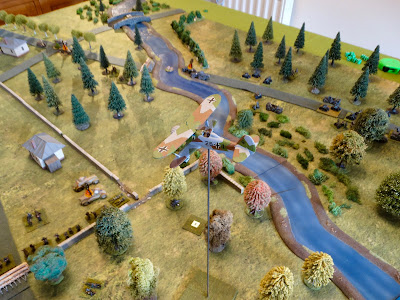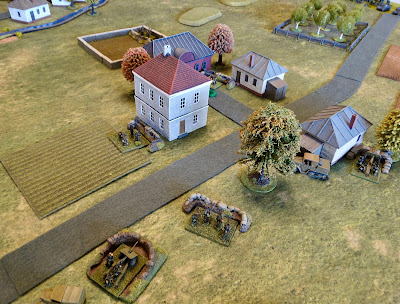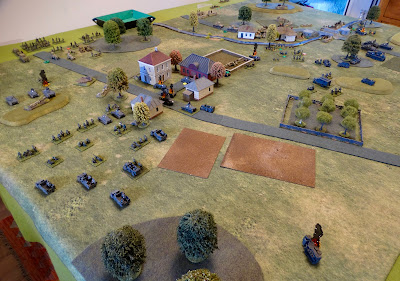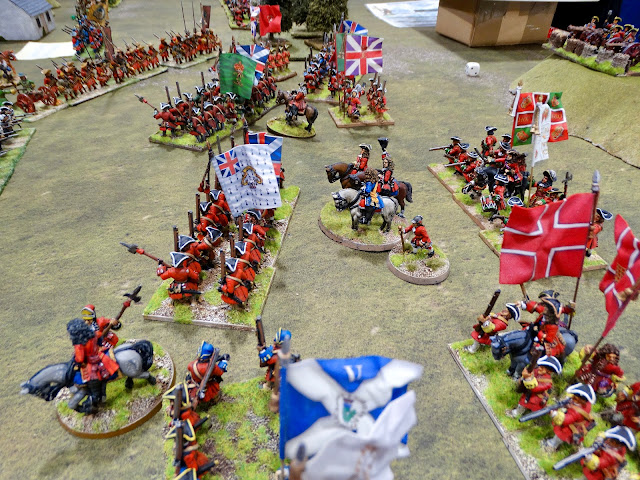Here we go with another WW2 scenario, played using my WRG 1973 revised rules. This time I was fortunate to have a live opponent - many thanks to Steve for coming over and helping out. If anyone finds the title and map of this scenario ringing some bells, both belong to a Napoleonic skirmish scenario laid out in WSS magazine a year or two ago. The original magazine is, alas, long lost, so I can't refer readers to the source.
Suffice to say that the Germans are attacking from the west, entering the table on move 1 along the two roads (sectors A and B on the map). Force A is based around a Combat Engineer platoon, force B is based around a Kradschutzen platoon. Their overall objective is to clear the wooded terrain of the enemy, and make a clear path for the tank units following them up. The Poles are there to delay them as long as possible. The four specific objectives are indicated by the red dots on the map, and as indicated in the scenario details the Germans have to take at least 3 of them to win. Game duration would be as long as we decided it was worthwhile - this was, after all, basically a test game.
As usual, the table was 6' x 4'. If anyone needs reminding, the models are 15mm or 1/100th scale. The Poles were free to dig-in as required.
Forces
How It Played
Due to the rules requiring elements of a platoon to stay within 200m of their command element, or 50m from each other, the Poles would need to deploy the cavalry platoon guarding one road, whilst the recce sections guarded the other. Thanks to Steve, I was able to see how my 'dummy counters' rules worked to disguise the details of the Polish deployment (quite well, as it turned out).
As so often with a new scenario, it turned out to be a little unbalanced, and the Germans had a tough time making progress without proper armoured support. Hence the recommended addition of an under-strength panzer platoon along each road. This should create a more mobile and equal game. You could try more armoured cars if you prefer, giving the Germans a full armoured car platoon of 4 or 5 vehicles down each road to give the Germans a proper chance of punching through the Polish defences.
 |
| Overview of the table, with dummy counters in place. |
 |
| The Germans made reasonable progress on the southern road. |
 |
| Things were a bit slower on the northern route, due to a nicely placed artillery strike which caused casualties and disruption. |
 |
| As dummy counters were revealed, it became necessary to winkle out Polish opposition. |
 |
| The leading armoured cars from the southern column reach the ford. |
 |
| The Polish 'strategic reserve', as Steve called them, take some mortar fire at the crossroads. Polish AFO seen behind. |
 |
| The Poles are making a stand at the northern roadblock. |
 |
| A German airstrike appears, but as so often the effect is limited. |
 |
| After 7 moves it was time for Steve to head home. German progress had been halted - it seemed they needed more mobile firepower to make a breakthrough. |
De-Brief
The Poles had won, but it seemed obvious the Germans needed a bit more 'oomph' to make a game of it - unless of course the Polish forces were reduced. So I think adding about 3 German tanks up each road should do the trick - the Germans will be able to overcome the initial Polish defences, giving them time to dismantle or go around the roadblocks before taking on the FT-17s.
This was Steve's first try at these rules, and he seemed to settle into them without too much trouble. He commented on their 'old school' feel, which is hardly surprising considering their vintage. Will he be abandoning Blitzkrieg Commander, his favourite rules of many years? I doubt it, but it seems we have an altenative set of rules with a different figure scale to add variety to our WW2 engagements.
To see Steve's report and his comments on the rules, go over to his excellent blog:
"Til next time!
























